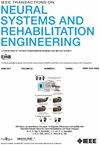Decoding Motor Excitability in TMS Using EEG-Features: An Exploratory Machine Learning Approach
IF 5.2
2区 医学
Q2 ENGINEERING, BIOMEDICAL
IEEE Transactions on Neural Systems and Rehabilitation Engineering
Pub Date : 2024-12-12
DOI:10.1109/TNSRE.2024.3516393
引用次数: 0
Abstract
Brain state-dependent transcranial magnetic stimulation (TMS) holds promise for enhancing neuromodulatory effects by synchronizing stimulation with specific features of cortical oscillations derived from real-time electroencephalography (EEG). However, conventional approaches rely on open-loop systems with static stimulation parameters, assuming that pre-determined EEG features universally indicate high or low excitability states. This one-size-fits-all approach overlooks individual neurophysiological differences and the dynamic nature of brain states, potentially compromising therapeutic efficacy. We present a supervised machine learning framework that predicts individual motor excitability states from pre-stimulus EEG features. Our approach combines established biomarkers with a comprehensive set of spectral and connectivity measures, implementing multi-scale feature selection within a nested cross-validation scheme. Validation across multiple classifiers, feature sets, and experimental protocols in 50 healthy participants demonstrated a mean prediction accuracy of利用脑电图特征解码经颅磁刺激中的运动兴奋性:一种探索性机器学习方法
脑状态依赖性经颅磁刺激(TMS)有望通过同步刺激与实时脑电图(EEG)产生的皮层振荡的特定特征来增强神经调节作用。然而,传统方法依赖于静态刺激参数的开环系统,假设预先确定的脑电图特征普遍表明高或低兴奋状态。这种一刀切的方法忽视了个体神经生理差异和大脑状态的动态特性,可能会损害治疗效果。我们提出了一个有监督的机器学习框架,从预刺激脑电图特征预测个体运动兴奋性状态。我们的方法将已建立的生物标志物与一套全面的光谱和连通性措施相结合,在嵌套交叉验证方案中实现多尺度特征选择。在50名健康参与者中,跨多个分类器、特征集和实验方案的验证表明,平均预测准确率为71美元;\ \下午;7美元%。顶层预测脑电特征的分层聚类揭示了两个不同的参与者亚组。第一个亚组,约占50%的参与者,在受刺激半球的感觉运动区域的α和低β波段显示出预测特征,与运动兴奋性和感觉运动节奏的传统关联一致。第二组主要在顶叶区域的低和高伽马波段表现出预测特征,表明这些个体的运动兴奋性受到更广泛的神经动力学的影响。我们的数据驱动框架有效识别个性化的运动兴奋性生物标志物,有望在临床和研究环境中优化经颅磁刺激干预。此外,我们的方法为跨不同神经调节范式和脑信号分类任务的生物标志物发现和验证提供了一个通用的平台。
本文章由计算机程序翻译,如有差异,请以英文原文为准。
求助全文
约1分钟内获得全文
求助全文
来源期刊
CiteScore
8.60
自引率
8.20%
发文量
479
审稿时长
6-12 weeks
期刊介绍:
Rehabilitative and neural aspects of biomedical engineering, including functional electrical stimulation, acoustic dynamics, human performance measurement and analysis, nerve stimulation, electromyography, motor control and stimulation; and hardware and software applications for rehabilitation engineering and assistive devices.

 求助内容:
求助内容: 应助结果提醒方式:
应助结果提醒方式:


